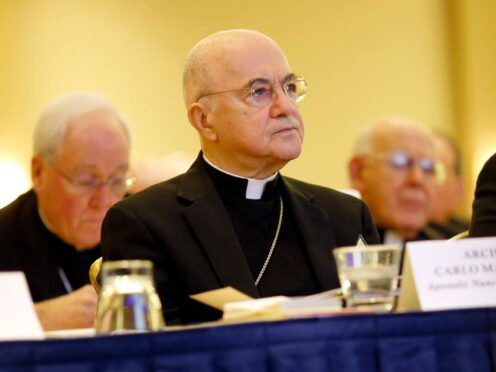
The Vatican has excommunicated its former ambassador to the US, Archbishop Carlo Maria Vigano, after finding him guilty of schism – an inevitable end for the firebrand conservative who became one of Pope Francis’ most ardent critics.
The Vatican’s doctrine office imposed the penalty after a meeting of its members on Thursday, a press statement said.
It cited Archbishop Vigano’s “refusal to recognise and submit to the Supreme Pontiff, his rejection of communion with the members of the church subject to him, and of the legitimacy and magisterial authority of the Second Vatican Council”.
The Vatican excommunication means that Vigano is formally outside the church, and cannot celebrate or receive its sacraments, for having committed one of the gravest crimes in canon law: schism.
A schism occurs when someone withdraws submission to the pope or from the communion of Catholics who are subject to him.
It is considered particularly dangerous to the faith because it threatens the unity of the church. And in fact, Vigano had created a following of like-minded conservatives and traditionalists over the years as he delved deeper and deeper into conspiracy theories about everything from the coronavirus pandemic, to what he called the “Great Reset” and other fringe ideas.
Vigano knew the schism declaration was coming after the Vatican informed him that it was launching a penal process against him last month. He defiantly called it “an honour” and refused to appear in person or in writing to defend himself.
After issuing a lengthy public statement last month justifying his conduct, he did not directly respond to the schism declaration on X, his usual forum.
About an hour before the Vatican decree was made public, he announced he would be celebrating a Mass on Friday for those who have been supporting him and asked for donations.
Vigano first burst into the public’s awareness in 2012, during the first Vatileaks scandal, when the late Pope Benedict XVI’s butler leaked the pontiff’s private papers to an Italian journalist to try to draw attention to corruption in the Holy See.
In some of the leaked letters Vigano, then number two in the Vatican City State administration, begged the Pope not to be transferred after exposing corruption in the awarding of Vatican contracts that cost the Holy See millions of euro.
By the time the letters were published, Benedict had transferred Vigano to be the Vatican’s ambassador to the United States – a prestigious post, but one that took him far from Rome and out of the running to one day be a cardinal.
Vigano reappeared on the scene during Francis’ 2015 visit to the United States, which as nuncio Vigano helped organise. Everything was going fine until Vigano arranged for Kim Davis, a Kentucky clerk at the centre of the US gay marriage debate, to be among a small group of people at the Vatican residence to greet Francis.
Ms Davis had risen to prominence for refusing to issue all marriage licenses rather than be compelled to issue licenses to same-sex couples. She became a hero to the conservative right in the US, with whom Vigano had increasingly identified during US culture wars over gay marriage and religious liberty issues.
After the visit ended, Ms Davis and her lawyers claimed the encounter with Francis amounted to an affirmation of her cause.
The Vatican later turned that claim on its head when it released footage of what it said was the “only” private audience Francis had in Washington: with a small group of people that included a gay couple.
Vigano’s deception in inviting Ms Davis to meet the Pope appeared to put the two on what would become a collision course that exploded in August 2018.
At the time, the US church was reeling from a new chapter in its clergy sex abuse scandal: One of the most senior American churchmen, Cardinal Theodore McCarrick, had been accused of molesting a minor and a Pennsylvania grand jury had issued a devastating investigation into decades of abuse and cover-up.
As Francis was wrapping up a tense visit to Ireland, Vigano published an 11-page screed accusing him and decades of US and Vatican officials of covering for McCarrick. Specifically, Vigano accused Francis of rehabilitating McCarrick from sanctions imposed by Benedict, and called on him to resign.
The accusations were explosive and helped create the greatest crisis of Francis’ then-young pontificate.
Francis quickly authorised an in-house investigation to determine who knew what and when about McCarrick’s penchant for sleeping with his seminarians.
The report, released in 2020, confirmed that a generation of church officials, including Pope John Paul II, had turned a blind eye to McCarrick’s misconduct. It largely spared Francis who eventually defrocked the churchman.
But the report also faulted Vigano for not looking into new claims against McCarrick or enforcing Vatican restrictions on him when specifically ordered to do so by the Vatican.
At that point, Vigano’s claims against Francis began to become more unhinged. He endorsed conspiracy theories about the coronavirus vaccines, appeared at far-right political rallies in the US and, eventually, refused to recognise Francis as Pope.

Enjoy the convenience of having The Sunday Post delivered as a digital ePaper straight to your smartphone, tablet or computer.
Subscribe for only £5.49 a month and enjoy all the benefits of the printed paper as a digital replica.
Subscribe